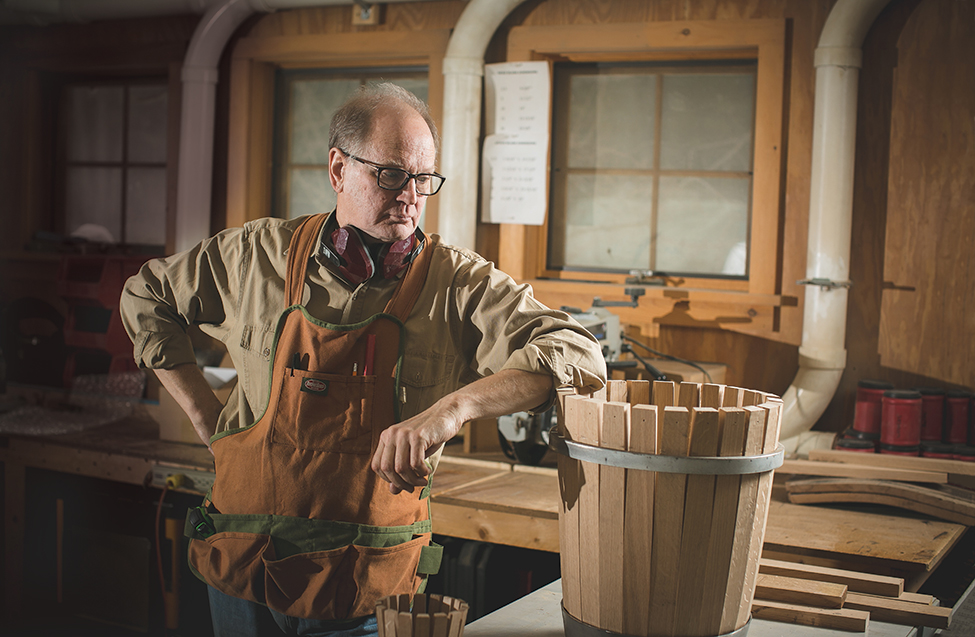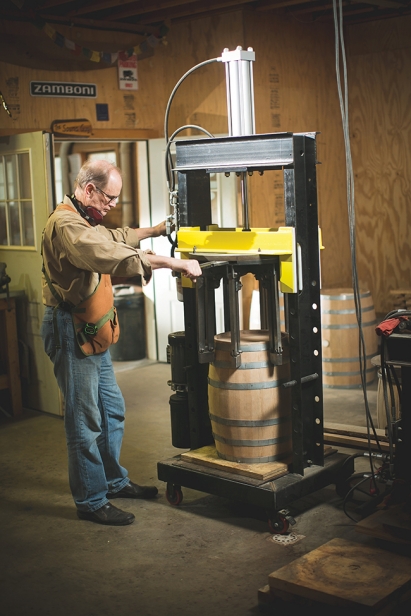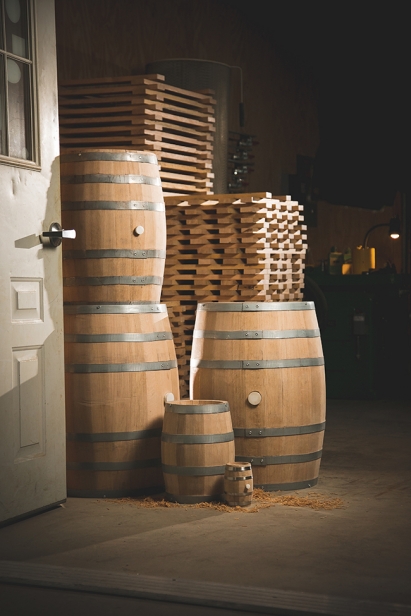Bob Hockert and His Old School Cooperage
No wonder coopering is a lost art. It takes a hell of a long time to make a wooden barrel. But the explosion in craft spirits has created a dire need for these containers. So Bob Hockert, founder of U.S. Barrel outside of Lake Placid, heeded the signs around him and became a master cooper known for his premium quality casks made of sustainably harvested New York white oak. Without such vessels, we’d all be sippin’ moonshine instead of barrel-aged bourbon. And that’s no slam on unaged white whiskey either.
“I can’t keep up with demand! Unlike the big guys, we build each barrel to spec, one at a time,” Bob said. Call it the slow barrel movement perhaps. And that’s the way he likes it.
Up until the early 20th century, every town, ship, and railroad had their own dedicated cooper. As did breweries, distilleries, and wineries. Different disciplines of coopers knew how to match the wood with the product to be shipped or stored. Knowledge and skills were passed down the generations. Wooden barrels were the ideal shipping container because they kept liquids in, materials dry, and moisture out. Their durable construction ensured longevity if well maintained. It’s amazing to think they’re still crafted with just two materials: wood staves and metal hoops. Not a nail, no glue.
The process can be sped up with machines and manufactured assembly-line style, or they can be crafted by one person using only hand tools. Down in Kentucky, one industrial cooperage cranks out thousands of barrels daily. Up in the Adirondacks, at the base of Whiteface Mountain, Bob and his two employees, Justin Bidelspach and his dad Chris, are pleased if they produce two or three casks a day.
U.S. Barrel is New York State’s oldest cooperage and the first since Prohibition. It began in … 2004. Bob started out building enormous barrel-shaped cedar saunas popular with the winter crowd. Two years later, a distiller in the area asked if Bob could make some barrels for his spirits. Always up for a new challenge, Bob readily agreed. U.S. Barrel now manufactures a broad array of items including wooden casks from 650ml to about 1,500 gallons, brining tubs, rain barrels, fermentation tanks, mugs, sauna barrels, whatever someone wants. “We love special projects that allow us to create and innovate,” Bob said. “If it’s round and made of wood, we’re up for it!”
Bob spent his first career on Wall Street but moved permanently to Wilmington, New York in 2004 where he and his wife, Sue, had a home for 20 years. His engineering degree now comes in handy as he operates his business, designing and building many of the machines himself. He also works closely with a talented machinist in town. “Up here in the Adirondacks, we need to be self-sufficient, fabricating and fixing our own equipment.”
Just like his predecessors, Bob matches wood to project. Sugar maple, cherry, yellow birch, fir – each imparts unique characteristics to the vessel underway. But white oak remains his primary material for whiskey barrels with its tight grain, durability, and resilience. He sources the majority from western New York, the Finger Lakes, and the Hudson Valley. White oak also grows well in southern Vermont, Massachusetts, and Pennsylvania.
“We look for old growth oak, 90 to 100-plus years old. Trees that grow deep in the forest compete for canopy and therefore grow straight and true to get the most sunlight for photosynthesis. Those trees will have the longest and straightest grain,” explains Bob.
A barrel’s journey begins in the woods. A logger fells the trees, a sawyer cuts them into manageable lengths, and a miller saws them into rough cut boards. “Quarter sawn oak is labor intensive. It’s specialty cutting that most mills don’t want to bother with,” said Bob. The boards are carefully stacked in ricks to ensure air circulates between the boards and left outside to dry for six months to a year.
Fresh cut oak contains 85% moisture so it seasons as it dries. Think of a thick slab of prime beef aging in a butcher’s meat locker, with all manner of flavor-enhancing molds and bacteria penetrating the surface. As the oak decomposes, spores help to oxidize the natural sugars (ya never thought about wood containing sugar, eh?) Nature cleanses the boards with her cycles of rain, sun and wind, softening the harsh tannins and eliminating off odors or impurities. Kiln drying is great for firewood but that process actually kills all the desirable molds and bacteria that lend flavor and complexity to the finished barrel.
100% of a whiskey’s color and up to 75% of its flavor derive from the barrel. Storage conditions impact a whiskey’s profile as well. If a barrel of whiskey ages in a room with fluctuating temperature and humidity, it will develop far more complexity than whiskey aged in a climate-controlled facility. If the room gets hot and humid in summer, then cold and dry in winter, the atmospheric pressure will push the spirit through the charcoal layer and into the wood where it picks up rich vanillins and pleasant tannins. As the whiskey passes back and forth, the charcoal acts as a natural filter and smoothes out any harshness. That’s why a barrel stored at consistent 72 degrees and 40 % humidity will produce a boring whiskey.
Size matters. The smaller the barrel, the faster the whiskey ages. The ratio of volume to charred surface area changes with the size of the barrel. More access to charred oak means deeper flavor and richer hue.
Ideally, whiskey production is a collaborative effort between cooper and distiller. “Every step of the process, from how we raise and toast each barrel, has a huge impact on how the spirit evolves,” Bob said. “A whiskey is the end result of marrying the distilled spirit with the unique characteristics of the barrel.”
He continued, “I prefer working with several smaller distillers rather than commit to one big name. It’s fun to be a part of a new business getting off the ground. It’s a symbiotic rapport; we all learn together,” Bob said. “Everyone comes to the table with distinct resources and abilities, then we put together the puzzle.”
Prohibition might have killed the cooperage industry but the resurgence of craft distillers and wineries is reviving the art. “We could actually use more barrel makers to help meet the demand,” Bob said. In fact, he would love to share his knowledge with people and train them to start up cooperages in their own locale. “It doesn’t make sense for people like us to be making and shipping barrels off to Alaska or other far flung places. 150 or 200 years ago, breweries and distilleries used to have their own cooperages on site as part of the whole business. It may be time to return to that practice.”
“If someone told me I’d be a cooper at this point in my life, I’d have written him off as a lunatic! I just wanted to get out of the city and come up here to lead a simple life. But it’s been a serendipitous trip with the right people and opportunities coming along at the right time. Whenever we hit a dead end, somehow the right solution shows up in our path. It happens constantly. We just have to be attuned and open to the new idea.”
Simple life, maybe not. Richly rewarding and pretty darn fun? Bob will drink to that.
To learn how a barrel is actually crafted step by step, pick up a copy of Edible Capital District Issue 6!








